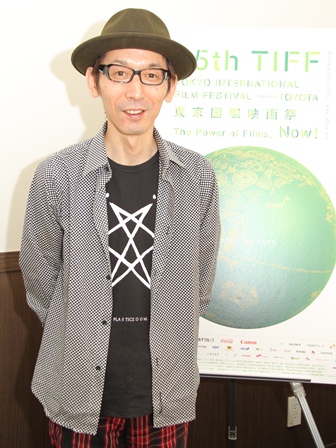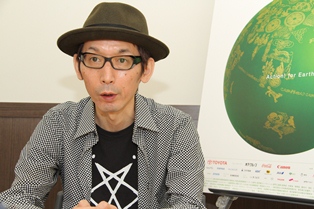Interview with Director Yutaka Tsuchiya (“GFP Bunny“)

In Yutaka Tsuchiya’s video-movie “GFP Bunny,” someone says, “There is no such thing as a story.” In other words, real life does not follow a narrative, the form in which movies are usually presented. The main character, an unnamed teenage girl played by Yuka Kuramochi, is obsessed with “observing,” because she only believes in what can be proven empirically. The movie itself is rather clinical, and the fictional content is often interrupted by interviews with real experts who expound on the subjects being covered. If “GFP Bunny,” part of the Japanese Eyes section, can be said to have any kind of story, it’s one based on a real incident that happened in 2005. A girl methodically poisoned her mother with thallium, recording her observations on her blog.
“Throughout the film the girl reads her diary,” says Tsuchiya during an interview at the TIFF office, “and most of the text is exactly what she wrote on her blog, which is still open to the public. You can read it. It’s archived.”
She dutifully notes dosages she secretly administers to her mother and the physical reactions. She also dissects live frogs, takes numerous photos and videos of natural phenomena with her phone camera, and experiments on one of her mother’s pet goldfish. “It’s about control,” she says to the director, who occasionally breaks through the fourth wall to talk to the girl (Yuka Kuramochi). “It’s the same as what you’re doing to me.”
“In an abstract way she is losing her human capacity as defined by conventional wisdom,” Tsuchiya says. “But she’s learning to grasp a new version of what it means to be human, something the rest of us may not grasp yet.”
Some viewers will misunderstand the movie’s dramatic development if they approach it in the usual way. In several scenes, the girl is mercilessly bullied by classmates, and when the original case was reported the media implied that her behavior was a reaction to the abuse. Tsuchiya didn’t buy it.
“What was reported was what was in the media,” he says. “And what was real could have been entirely different.” In one scene the director even confronts the girl directly with this interpretation and she vehemently denies that the bullying affects her. She won’t even acknowledge her tormentors.
By the same token, a rather slimy male teacher (Kanji Furutachi) tries to get her to admit, in a patronizing fashion, that she is being abused. She responds with undisguised contempt. The teacher does not represent an ineffectual education system so much as a generation that cannot adapt to this changing definition of humanity.
“He says empty things like, ‘We are born free’ and ‘We must protect human dignity’,” Tsuchiya says. “Through him I want to show how some adults lack empathy. He is superfluous, a person without any moral weight. We need to be more analytical and look at ourselves more deeply.”

In contrast, the extreme body modification aficionados (piercings, tattoos, injections) depicted in the movie are more honest–maybe even freer. The girl’s mother (Makiko Watanabe) is presented as a ridiculous figure, partly because she undergoes cosmetic surgery to counteract the effects of aging. Cosmetic surgery is regressive adaptation, since it represents an effort to achieve or return to a conventional idea of youthful attractiveness. Body modification enthusiasts want to change into something new. “They are people who really want to feel their own bodies as their own bodies,” Tsuchiya points out. “Modification is one means of controlling their bodies without being invaded by others. It might be an eccentric way of going about it, but…”
If this is a means of artificially speeding up evolution, Tsuchiya is not sure if it’s a good idea. The girl says that all humans are “prisoners” and Tsuchiya elaborates. “We are prisoners of globalism and consumer culture, but also of our own DNA,” he says. “Thirty percent of people over the age of 60 will get cancer. It’s programmed into the species and we can’t change that no matter how hard we try.” This concept informs the titular metaphor, a rabbit that has been genetically engineered to glow in the dark, which is seen as an “improvement,” though society has yet to reach a consensus on the benefits of artificially achieved evolutionary acceleration.
Tsuchiya doesn’t pass judgment on the girl’s actions, a decision that may make viewers uncomfortable. In the 2005 case, the media backed its theory that the girl suffered from a developmental disorder by pointing out she killed animals. In the film, Tsuchiya uses animals in ways that are sometimes disturbing, and which question the upward march of civilization. “When you look at how human beings have developed methods to use animals for their benefit, you could call it progress,” he says. “For instance, chickens are bred in a way to produce more eggs. But that’s technological progress, and it involves a process of selection.” Whether this progress is good or bad, Tsuchiya won’t say. “In any case, we cannot go back.”
(Text by Philip Brasor)



















